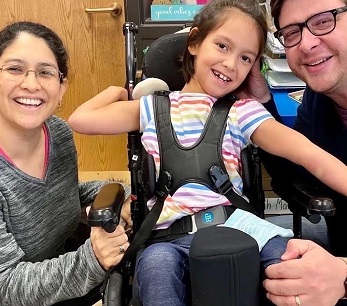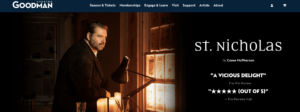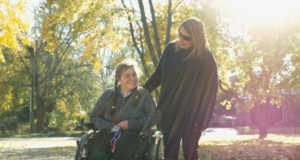by Alicia Krage
 Before reading, be sure to catch Part 1 and Part 2 of this story!
Before reading, be sure to catch Part 1 and Part 2 of this story!
The interview questions were precisely the ones my parents had asked when we were practicing. I had a question I wanted to ask them, but I was hesitant to ask. I was worried my question would blow everything.
When the interview was over, the interviewer said, “It’s been a pleasure meeting with you!” I felt my window of opportunity start to close. But then the interviewer opened that window right back up again with five little words: “Do you have any questions?”
“Actually, I do,” I said, plastering on a smile, hoping for the best. “I’ll be honest here. Because I take the bus, I don’t feel I know the campus well enough to give campus tours…I mean, I’ll certainly help out if you need it, I’m just asking if…if it would be a problem for me to primarily work the call center shift.”
“We need more people working the call center shift, anyway,” she said. I heard the smile in her voice, and that gave me a huge sense of relief. “That’s no problem at all. Thanks for asking!”
Six days later, I got the email congratulating me on getting the job. My fingers were flying on the screen, typing as fast as I could, texting my immediate family in a group text. “I got the job!!!!!” I wrote, hoping multiple exclamation marks would help them hear my enthusiasm.
Group training sessions were next, and a lot of the initial training involved loads of paperwork. I had someone read it all to me and help me fill it all out, and then at group training we learned a lot about each building on campus and what each building consisted of : type of classes that met there, what major, that sort of thing. One day after training, one of the employers asked me to stay back for a second so she could ask me a question. I’d normally get anxious and think something was wrong, but I wasn’t worried. I felt strongly that I really fit in here, but the question she asked confused me. “Are you free at all next week?”
Free? Free for what? Before I could ask, she went ahead and explained. “I’d like to meet with you one-on-one,” she said. ”That way we can go over the website we use for the call center.”
Oh, no. The last time I’d applied for a job at a call center, the web site was the reason I got turned down for the job. The website used for that call center made calls automatically. They didn’t need a person.
“Oh, the calls are made automatically on the computer then?” I asked, trying not to sound too panicked, although internally, I was.
“No,” she replied, calmly explaining that the website they use displays the name of the person you’re calling on the screen, and they’d like to go over it with me to make sure it works with my computer and software. “and if it doesn’t, we’ll have the entire summer to work with the Disability Resource Center to fix it.”
I can’t even put into words the feeling of relief that coursed through me at the sound of those words. We met a week later and she talked me through how to use the site, step-by-step. We didn’t need any extra help. It was accessible.
So, training lasted the rest of the semester, and I have the job now. I work in the call center, making calls to prospective students to promote campus events or follow up after a recent one.
I spent my first few weeks on the job calling students who had recently toured our campus, so it was more of a survey. What was your favorite part of the tour? What could we improve on?
For now we are calling students to invite them to our open houses, and one specific call stands out. I called a student, and their mother ended up answering the phone. What is normally a one-minute call turned into maybe 15 minutes! Somehow a call about an Open house turned into her asking me about majors, if it’s possible to change your major, how easy it is to do that. This call was seriously going off-script. I hesitated a minute before answering those questions of hers. How long were we allowed to have conversations with these people? I didn’t sense anyone standing nearby, looking over my shoulder or anything, so I chanced it.”It’s pretty easy,” I said, letting her know I had changed my major.
“Oh, you did?” she replied. “What did you major in before, if I might ask?”
“I was a sociology major,” I told her. We discussed how to change majors, how simple the process was, and about my own experience attending campus events.
“Did you go to the open house?” she asked.
“I’ll be honest with you – I did not,” I said, wincing at my own response. I was promoting this event I’d never gone to. Oops. I was hoping no one heard that. I was also hoping this mom on the phone would appreciate my candor.
“I did go to the orientation for transfer students, though. There were presentations, and then we were grouped up by major and got a tour, I think. It was so long ago, I don’t remember specifics, but it was a lot of fun. I’m sure your son will really like it – I know I did.”
“You were a transfer student?” she said, excited. “Oh, where did you transfer from? My son is a transfer student, too!”
I smiled, marveling at how we’d even gotten to talking about community college instead of the upcoming open house, but not really caring about checking the clock. I wanted to keep the connection…literally. I wanted her to stay on the line. I was going really, really off script but I was helping, giving her information – and giving her hope for her son. Or something like that.
“College of DuPage,” I said.
“Oh! I’m from that area!” she answered. I laughed, then I knew I had to end this at some point. “It’s a good school,” I said. “I do need to make other calls, though, but it was really nice to talk to you. I hope I was helpful.”
“Thank you!” the mother replied. “Sorry for keeping you on so long.”
I reassured her that it was all fine. “I’d love to answer more questions, I just…kind of can’t.” I said with another laugh. “But really, it was good talking to you, and I’m glad I seemed to know more than I thought I did!” When we hung up, I felt like I had really made a difference, and that I’d really done a great job representing our school.
Some students might dread going to work after a long day of class, but I love it. It’s the highlight of my day. I love the job and I love the people I work with. I’m so grateful. I get the chance to talk to a variety of different people, represent our campus – and most of all, feel a sense of belonging.
 It’s no secret around the Walke house that I love Halloween. Perhaps it’s because it’s the last few days of decent weather, before the stress of the winter holidays sets in, and the last few days of daylight savings time. More likely is that Halloween provides me with an excuse to buy tacos de sesos (tacos made with brain).
It’s no secret around the Walke house that I love Halloween. Perhaps it’s because it’s the last few days of decent weather, before the stress of the winter holidays sets in, and the last few days of daylight savings time. More likely is that Halloween provides me with an excuse to buy tacos de sesos (tacos made with brain).







 Before reading, be sure to catch
Before reading, be sure to catch




